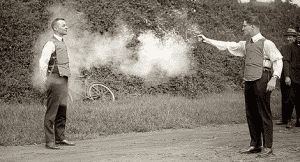 Welcome to installment seven of the Nine Dangerous Mindsets series. While these mindsets may have many dangerous implications, my focus is to bring light to how they can impact situational awareness and team safety. I have been receiving some amazing feedback so far on this series. Readers are sharing that I have struck a chord, talking about behaviors and mindsets they know are dangerous but no one has talked about openly. I hope this series has been helpful in opening up dialog with your members.
Welcome to installment seven of the Nine Dangerous Mindsets series. While these mindsets may have many dangerous implications, my focus is to bring light to how they can impact situational awareness and team safety. I have been receiving some amazing feedback so far on this series. Readers are sharing that I have struck a chord, talking about behaviors and mindsets they know are dangerous but no one has talked about openly. I hope this series has been helpful in opening up dialog with your members.
In this contribution I am going to discuss the Superman/Superwoman dangerous mindset. You might think of this as the person who sees him or herself as unstoppable, bullet proof, invulnerable or invincible. The Superman/Superwoman can leap tall buildings in a single bound, run faster than a speeding bullet, etc., etc. You get the idea… super powers and super abilities. The only problem is, simply because they think they can, does not mean they can. This is at the heart of this dangerous mindset.
How is it a person comes to think of themselves as being invincible? For some, it may start as early as their teenage years and I was the victim of this mindset. When I was younger I never gave one ounce of consideration to my vulnerabilities. I lived in the edge. The more dangerous things were, the more exciting they were. The excitement of doing dangerous things can be addicting. No, really, it can be. The chemicals that are released in the brain when you are under stress are very powerful. Two neurotransmitters in particular, endorphins and epinepherine can be very addicting.
Endorphines
 The word endorphins is a hybrid of two words: Endogenous Morphine. Yes, your brain produces morphine. Endorphins are produced by the pituitary gland and the the hypothalamus. Many things can trigger the release of endorphins and one of them is the stress that comes from doing dangerous things. Doing dangerous things, especially when you get away with it, can be exciting. A person who does dangerous things over and over again can, unknowingly, get addicted to the morphine dump.
The word endorphins is a hybrid of two words: Endogenous Morphine. Yes, your brain produces morphine. Endorphins are produced by the pituitary gland and the the hypothalamus. Many things can trigger the release of endorphins and one of them is the stress that comes from doing dangerous things. Doing dangerous things, especially when you get away with it, can be exciting. A person who does dangerous things over and over again can, unknowingly, get addicted to the morphine dump.
Epinepherine
 Epinepherine is also known as adrenaline. Like endorphins, adrenaline is also a neurotransmitter. But unlike endorphins, adrenaline is not released in the brain. It is released by the adrenal glands which sit on top of your kidneys. Adrenaline is also a stimulant. It helps the body prepare for the the “fight or flight” response by stimulating muscles that will be needed to defend yourself or to run away from danger. The stimulation created from adrenaline can also become addicting.
Epinepherine is also known as adrenaline. Like endorphins, adrenaline is also a neurotransmitter. But unlike endorphins, adrenaline is not released in the brain. It is released by the adrenal glands which sit on top of your kidneys. Adrenaline is also a stimulant. It helps the body prepare for the the “fight or flight” response by stimulating muscles that will be needed to defend yourself or to run away from danger. The stimulation created from adrenaline can also become addicting.
Adrenaline Junkie
 The term ‘Adrenaline Junkie’ has been used to characterize a person who favors high risk activities because of the ‘high’ they experience when they are under stress. Some marathon runners describe getting a ‘runner’s high’ when participating in a distance race that pushes their endurance to the limits. The stress on the body from running triggers the release of these neurotransmitters.
The term ‘Adrenaline Junkie’ has been used to characterize a person who favors high risk activities because of the ‘high’ they experience when they are under stress. Some marathon runners describe getting a ‘runner’s high’ when participating in a distance race that pushes their endurance to the limits. The stress on the body from running triggers the release of these neurotransmitters.
Bulletproof Confidence
 In addition to the challenges that come from neurotransmitters, a person who engages in high risk activities that do not result in consequences can lead to a false sense of confidence that they are, somehow, immune to having bad outcomes. Why? Because they never do. They begin to see themselves as being gifted and talented where, in fact, they’re just being lucky. The luckier they are, the more their confidence rises.
In addition to the challenges that come from neurotransmitters, a person who engages in high risk activities that do not result in consequences can lead to a false sense of confidence that they are, somehow, immune to having bad outcomes. Why? Because they never do. They begin to see themselves as being gifted and talented where, in fact, they’re just being lucky. The luckier they are, the more their confidence rises.
This false confidence can result in a very dangerous mindset for even if they, on occasion, suffer a loss (a bad outcome) they can actually attribute the bad outcome to a short term stroke of bad luck. You see what’s happened here? They don’t see their many successes as good luck. They see their occasional failures as bad luck. The more good fortune they experience, the more bulletproof they feel.
Taking You Down With Them
 When a person sees him or herself as bulletproof, it can be very difficult for them to see their vulnerabilities. Chances are these people have had many successful outcomes while engaging in high risk, high consequence activities. This can give them a sense of confidence and it can cause them to judge, often harshly, others who engage in the same activities and have bad outcomes. It may also cause them to denounce those who are not willing to take the same risks and this can cause problems for responders.
When a person sees him or herself as bulletproof, it can be very difficult for them to see their vulnerabilities. Chances are these people have had many successful outcomes while engaging in high risk, high consequence activities. This can give them a sense of confidence and it can cause them to judge, often harshly, others who engage in the same activities and have bad outcomes. It may also cause them to denounce those who are not willing to take the same risks and this can cause problems for responders.
An overconfident person can fail to develop and maintain situational awareness because they let their guard down. Even if they see clues and cues that indicate bad things may be on the horizon, they can dismiss them as being unimportant. They may not even see the clues and cues.
I have demonstrated this fact many many times in my Mental Management of Emergencies program. If your brain does NOT want you to see something that exists, you WON’T see it. Conversely, if your brain wants you to see something that does NOT exist, you WILL see it. The brain of an overly confident Superman or Superwoman, hiked up on endorphins and adrenaline may not work the same as yours.
Dr. Gasaway’s Advice
 The consequences of a Superman or Superwoman dangerous mindset can be significant if this person has authority or influence over others. Their mindset may draw other responders into engaging in high risk, high consequence situations they should not be in. If another person has formal authority over the Superman or Superwoman, the behavior may be halted. But sometimes it’s not. This can occur because the supervisor may also, after repeated exposure to the Superman or Superwoman, come to believe their performance outcomes are based on skill and not luck. Or, the supervisor may be afraid to speak up, fearful the Superman or Superwoman will lash back at them or go on the offensive.
The consequences of a Superman or Superwoman dangerous mindset can be significant if this person has authority or influence over others. Their mindset may draw other responders into engaging in high risk, high consequence situations they should not be in. If another person has formal authority over the Superman or Superwoman, the behavior may be halted. But sometimes it’s not. This can occur because the supervisor may also, after repeated exposure to the Superman or Superwoman, come to believe their performance outcomes are based on skill and not luck. Or, the supervisor may be afraid to speak up, fearful the Superman or Superwoman will lash back at them or go on the offensive.
The Superman/Superwoman dangerous mindset can build a level of confidence that results in a denial of vulnerability. The first step, as with any affliction, is to acknowledgment the problem exists. One way to do this is to use a third-party example of how this dangerous mindset adversely impacted someone else. This is one of my favorite ways to help someone see their shortcomings without being so direct and personal.
It starts with telling a story about someone the afflicted person does not know. The person in the story has the same qualities as the person you are talking to. The key is to never make a direct correlation. In other words, don’t say something like “This person has the same sense of invulnerability as you.” This will only serve to antagonize. The story’s plot line is strikingly similar to the situation you are experiencing. The discussion dances right up to the heart of the issue without being direct. The connection to your real-life scenario is left inferred. Sometimes asking the afflicted member for advice might be helpful. For example, “Joe, what do you think I should tell my friend about how to manage this problem?”
It may even be helpful to make the scenario so different that the direct connection is not plausible. For example, if you are a firefighter, use a police example. If you are a police officer, use a military example, etc. The important thing is to get this out on the table and talk it out. The Superman/Superwoman mindset is not only dangerous for them, but it is also dangerous for you.
Action Items
 1. Discuss if your department has anyone with a Superman or Superwoman mindset. If so, discuss how it impacts the safety of members.
1. Discuss if your department has anyone with a Superman or Superwoman mindset. If so, discuss how it impacts the safety of members.
2. Discuss how this dangerous mindset can impact your safety and the safety of other responders. If this person has been let to get away with taking excessive risks, discuss why that has happened and how it may be remedied.
3. Discuss ways to insulate yourself from a person with this dangerous mindset. In other words, if you cannot stop them, how do you protect yourself against them.
_____________________________________________________

If you are interested in taking your understanding of situational awareness and high-risk decision making to a higher level, check out the Situational Awareness Matters Online Academy.
CLICK HERE for details, enrollment options and pricing.
__________________________________
Share your comments on this article in the “Leave a Reply” box below. If you want to send me incident pictures, videos or have an idea you’d like me to research and write about, contact me. I really enjoy getting feedback and supportive messages from fellow first responders. It gives me the energy to work harder for you.
Thanks,

Email: Support@RichGasaway.com
Phone: 612-548-4424
SAMatters Online Academy
Facebook Fan Page: www.facebook.com/SAMatters
Twitter: @SAMatters
LinkedIn: Rich Gasaway
Instagram: sa_matters
YouTube: SAMattersTV
iTunes: SAMatters Radio
